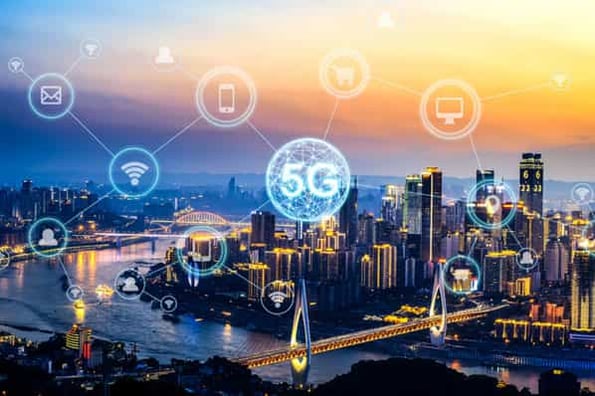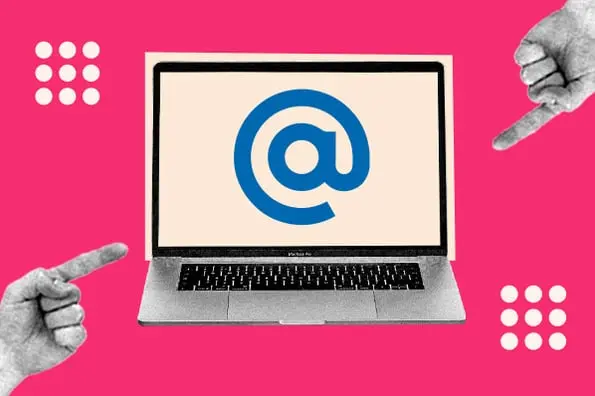By the end of 2019, the four biggest U.S. cellular carriers rolled out 5G across the country.

With the rollout of this new high-speed network comes a number of news articles, commercials, and promotional content explaining how 5G will dramatically change the world. It is believed that the mass adoption of the technology and the subsequent monetization of 5G will take off as early as 2025.
Despite all the 5G hype, you might still be asking yourself, "What the heck is 5G and how will it impact my business?"
What is 5G?
5G, which stands for fifth-generation cellular wireless network, is a cloud-based network that connects people on mobile devices to the internet faster than previous networks. While 4G requires cables and infrastructure to run smoothly in a neighborhood, 5G's cellular towers amplify cloud-based signals which eliminate many cable-related needs.
What makes 5G so revolutionary? While wireless networks of the past could only really power mobile devices up to the size of a tablet, 5G will be strong enough and fast enough to smoothly power computers, televisions, and even smart devices. This networking power has led tech bloggers to suggest that 5G will compete with -- or potentially limit the need for -- the Wi-Fi we currently use today.
At this point, you might still be asking, "If 5G is wireless internet and Wi-Fi is wireless internet, what's the difference?"
The Difference Between 5G and Wi-Fi
Wireless internet, Wi-Fi is unlicensed internet while 5G is a licensed cellular network. While you pay internet providers like Comcast to amplify your home's Wi-Fi signal so that it's useable, you'll pay cellular providers -- such as AT&T -- for 5G, which relies on signals from cell towers.
When it comes to infrastructure, 5G signals will come from one main 5G tower in a centralized location, such as the middle of a city. Then, that signal will be amplified by smaller cell towers around it -- often referred to as "small cells." This will cover a large distance of mobile devices with high-speed 5G networks. The 5G networks, run on the small cellular towers, will be licensed to specific cellular companies, such as Verizon and AT&T.
Here's a great graphic that shows how 5G is sourced from cell towers:

Meanwhile, Wi-Fi comes from radio waves sent from an internet provider's giant, central computer. The waves and frequencies of the waves are sent to your home or a Wi-Fi-connected place via an ethernet cable. These frequencies are decoded and recognized by your modem. Then, a router, which is like an antenna, amplifies the signal so you can use multiple devices to connect to Wi-Fi wirelessly in your location.
As you might notice, Wi-Fi and 5G will be purchased and used fairly similarly. The only incredibly obvious difference will be the speed of 5G compared to Wi-Fi and the fact that Wi-Fi connects you to browsers and apps via the internet, while 5G connects you with a cellular network.
While the two technologies are pretty similar, tech experts still say we'll need them both for the time being.
For example, while 5G is just getting started, Wi-Fi is already nearly everywhere. While you might still need to use Wi-Fi if your home isn't in the path of a 5G cell tower, you also might need to use 5G if your Wi-Fi connection is poor. Ultimately, experts are suggesting that these two technologies will work together to provide seamless experiences for those surfing and streaming throughout the web.
We're already living in a hyper-connected world. And, while 5G won't change everything dramatically, or all at once, it will amplify many of our current digital strategies while allowing us to explore more technological opportunities -- especially in the realm of AR, VR, AI, and smart devices.
If you're a small business marketer, the truth is that your day-to-day marketing processes probably won't change completely. But, you'll likely notice subtle changes and new technologies creeping in on the horizon.
While some of these changes might not impact the way you work until later on, 5G's pure speed might streamline or quicken your online marketing tasks in the near future.
Overall, the addition of 5G and even improved Wi-Fi networks will be a great thing for businesses that have an online or digital presence -- or marketers run many of their daily processes online.
To help you prepare for the new era of wireless networks, I'll note five ways that 5G could impact you and other marketers in the near future.
How 5G Will Impact Marketers
1. Your online presence will be even more vital.
If you think people can't get more connected to the web, think again. With higher loading speeds and better connectivity, people will likely consume even more online content on their computers, phones, and smart devices.
If you're behind on online marketing, it will be absolutely vital to start developing an online presence as people spend more and more time logged on to the internet and less time consuming traditional content, like cable TV, newspapers, and magazines.
So, how do you expand that web presence? Be sure to create or optimize your profiles on the major social media networks, including Facebook, Twitter, LinkedIn, and Instagram. If you haven't already, you should also launch a website, start a company blog, or consider creating marketing videos aimed at brand awareness.
Want to learn more about building a web presence? Check out this detailed guide.
2. You could see digital ads on more screens, surfaces, and alternative realities.
Today, we see digital ads on our phones, websites, and occasionally on screens at malls, shopping centers, or airports. With 5G and evolving Wi-Fi technologies, wireless internet will be faster and more abundant around the country -- even in the more rural locations. This means that digital ads could appear in more areas with a web connection. Furthermore, the visuals and media in each ad could be more advanced due to high network speeds.
Aside from being able to place high-quality advertisements on screens in more locations, marketing experts suggest that some brands might even experiment with alternative reality ads where people wearing special AR glasses or using AR cameras can see an ad pop up in whichever location they're in.
To help you visualize what this could look like, here's an AR strategy Burger King used to advertise its product in locations where its competitors had ads. When logging into Burger King's app, you could scan a McDonald's ad in front of you, set it on fire on your screen, and then see an ad with a Burger King coupon pop up.
Aside from AR, some also suggest that faster internet speeds could also open the door for functional holographic ads.
At the moment, holograms are actually being experimented on by larger brands. However, the technology is still very nascent and somewhat buggy -- which is why you probably haven't seen a hologram in real life just yet.
Here's an example of today's hologram technology:
3. Advertising will become more interactive.
Aside from a greater abundance of digital ads, marketing content could also get more interesting with the high-speed capabilities of 5G.
While ads that allowed viewers to interact with the content once seemed impossible with buffer time and other technological limitations, 5G could make this strategy more accessible to marketers.
To give you an idea of what interactive ads could look like, the video below shows examples of playable ads. These are ads for video games that allow you to play the actual game in the advertisement before downloading it:
4. AR/VR will get even more realistic.
For years, marketers at big brands have been experimenting with AR and VR. For example, some have created AR-based Snapchat or Instagram filters, while others are sponsoring product placement in VR-based video games.
As internet speeds get much faster with the dawn of 5G, marketing technology experts are expecting VR and AR to feel even more seamless. You can expect to see big brands continue experimenting with filters and gaming, but you might also see companies invest in branded immersive experiences, like this one:
5. Marketing processes -- like data collection -- will be improved.
Ever wanted to learn more about your customer or audience but didn't have time to track down tons of data or load multiple analytics reports? These problems could be in the past with future high-speed internet. As 5G becomes more robust, competing internet providers are also launching faster Wi-Fi. This means that regardless of how you connect to the internet in the near future, you'll likely run into less lag time and more capabilities.
As mentioned, one of the biggest tasks that 5G will positively impact is data gathering. While it once took marketers days or hours to do reporting or mine data that they could use to create personalized experiences, it might only take a few minutes or seconds. Along with being able to collect data faster, 5G will also allow marketers and cellular providers to collect more data than they could with Wi-Fi or earlier generations of cellular networks.
In a paper covering the impact of data and data collection with 5G, the IEEE wrote, "5G promises to enable intelligent network and application services with connectivity to remote sensors, massive amounts of IoT data and low latency data transmissions. Big Data analytics will no longer be an afterthought, and it will play a significant role in the evolution of 5G standards enabling the intelligence across network, applications, and business."
Aside from speeding up and improving vital but time-consuming data-related tasks, higher-speed networks will also result in less time or resources being needed for certain marketing projects or daily tasks. For example, 5G's speed could enable automation for more intricate tasks, or allow more seamless opportunities for in-office employees to talk to their remote colleagues virtually. These faster communication and automation capabilities could open up marketers to focus on more creative projects.
How to Keep Up in a 5G World
Even if your company doesn't feel quite ready to explore the possibilities of interactive advertising or AR/VR, you should still follow the world of marketing technology to keep up with what other big brands are doing. This will help you identify which opportunities might be more accessible to you in the future, or more scalable strategies where you can create similar strategies without high-priced technology.
Aside from keeping up with bigger brands, you should also be sure to build up your digital and online marketing tactics if you haven't already. If 5G, and the ongoing improvements of Wi-Fi, have taught us one thing, it's that there is a business case for being hyper-connected. If most of your consumers weren't already online frequently, they definitely will be in the coming years.
Make sure you're on the most popular social media channels for your industry. If you haven’t already, you should also consider creating digital content such as a website, marketing videos, and blog posts related to your brand.
If you've already got a killer online presence, consider experimenting with newer mobile platforms that could thrive in the world of 5G. For example, although you might not be able to afford to create an AR advertisement or experiential experience, you could look into creating content that utilizes AR or new-media filters on apps like Snapchat, TikTok, or Instagram.
Want to learn more about the technologies that could evolve with 5G? Check out this blog post on AR and this piece on artificial intelligence in marketing.




![The Top Marketing Trends of 2024 & How They've Changed Since 2023 [Data from 1400+ Global Marketers]](https://blog.hubspot.com/hubfs/Untitled%20design%20%2868%29.jpg)

![How to Delete Your Instagram [Easy Guide]](https://blog.hubspot.com/hubfs/delete-instagram.png)
![The Top Channels Consumers Use to Learn About Products [New Data]](https://blog.hubspot.com/hubfs/finding-products-on-social-media.png)
![The State of Consumer Trends in 2023 [New Data]](https://blog.hubspot.com/hubfs/consumer%20trends%202023-1.png)
![Millennials vs. Gen Z: Why Marketers Need to Know the Difference [New Data]](https://blog.hubspot.com/hubfs/millenials%20vs%20gen%20z%20what%20marketers%20need%20to%20know%20when%20trying%20to%20reach%20each%20generation.jpg)

![Top Shopping Trends of 2023 & How They've Changed [New Data]](https://blog.hubspot.com/hubfs/shopping-trends_3.webp)